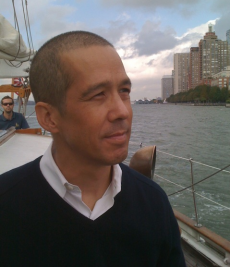
A former Discreet artist, with major roles at Quietman and Brandname (via PS 260), Colin Stackpole has long been an Inferno artist in demand, lending his touch to Super Bowl spots, music videos and campaigns for Gillette, GE, Pepsi and Fox Sports and showing up in the 2009 book, The Visual Effects Arsenal: VFX Solutions for Independent Film Makers. Last year he co-founded the boutique VFX/production company Light of Day with one former colleague and friends of friends who shared similar worldviews, both in and out of the studio. Light of Day has since worked on a string of genre-busting spots that blend cinema-style effects and interactive complexity. For fashion designer Hugo Boss, Light of Day collaborated with concept video artist Marco Brambilla and Blast Radius, a digital agency that grew out of WPP, to create something that steps way beyond the average runway promenade.
Take a look at the Brambilla/Hugo Boss video, below, then read the interview. (You can also spend time with Brambilla's epic Civilization in the elevator at New York's Standard Hotel, where it plays in a constant loop.)
Q: What brought you and the other Light of Day founders together?
A: Well, Amy Taylor and I worked together at a previous company. I met Charles Nordeen through a good friend when we all went surfing together, and Josh Williams through a few mutual friends we both did business with. The type of Creative/Post house we were creating and online department was a key component and vice-versa from his side.
Q: Describe your process working with Marco Brambilla on the Hugo Boss piece, KINO. Did he have very specific color shifts in mind?
A: Working with Brambilla was a great experience and the Hugo Boss project was interesting to do for a few key reasons, one being that the final deliverable was to a digital company, Blast Radius, who then made the piece interactive and two, the entire piece was built from scratch. There was no one shot that was the master shot or even a background plate. That being the case we used multiple shots which were motion control, we built CG elements, and used still images.
Q: Was Light of Day involved in the programming of KINO's interactive version that let users choose from three different points of view?
A: It was a tight collaborative effort with us and Blast Radius to make sure the interactive part really came together. Once we had the multiple motion control shots, incorporated the CG elements and used still images, we were able to separate the scenes out and create a bookend so the video could buffer the next sections when one scene was playing down in order to optimize it for web viewing. Afterwards, Blast Radius made it so you could change between the different layers (Theatrical, Movie Magic, Performance) by moving your head as the viewer's web cam tracked their movement.
Q: You got your start as a Flame and Inferno artist. What other software and hardware is critical to Light of Day's current work?
A: We are a Flame/Smoke boutique but we rely heavily on After Effects for design and Maya for our 3D elements—all run by some of the best artists I've met in my years in the industry. We also have a high-end color suite running Autodesk Lustre and we use DaVinci for our dailies. Several Nuke stations aid in our 3D compositing. We also have Massive, which we just used for zombie crowd replication in the NY Lottery spot Zombies directed by Jim Jenkins.
Q: If you could choose one thing—commercial, film, art work, technology or something else—that has inspired you in the past year, what would it be?
A: The one thing that has inspired me this year aside from technology, which always evolves, is the incredible hard work and dedication the staff and partners at Light of Day have put in to make this place the best and most creative environment I have ever worked in. Everyone here is committed to doing the absolute best job possible and every person here is constantly educating themselves and raising the creative bar. It truly has been the most enjoyable time of my career so far!